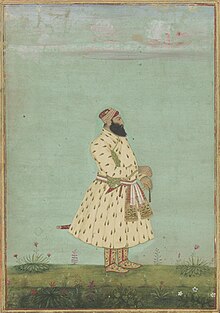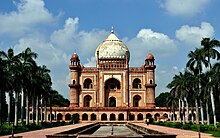Safdarjung
Safdarjung or Safdar Jang ( Hindi सफ़्दरजंग , Urdu صفدرجنگ; born around 1708 in Persia ; died October 5, 1754 in Sultanpur , India ) or with full name Abul Mansoor Muhammad Muqueem or Abul-Mansur Khan Safdar Jung was of Persian descent and from 1739 to 1754 the second ruler of the province of Avadh (or Oudh ) im, which became practically independent in 1732 North india. From the politically weak Mughal rulers Muhammad Shah (r. 1720–1748) and Ahmad Shah (r. 1748–1754), he received numerous other offices and titles, so that he rose to become one of the most influential and wealthy men in the country.
history
background
Under the rule of the Sultanate of Delhi (1206–1526) and under the early Mughals, the province of Avadh with the capitals Faizabad and Lucknow , located about 500 km southeast of Delhi or Agra and known by many as the “granary of India”, was governed by governors ( subahdars or nawabs ) . During the decline of the central power of the Mughal empire after Aurangzeb's death (1707), numerous princely states developed from the former provinces , which were legally under the respective ruling Mughal emperors until 1858, but were in fact ruled independently. The province of Avadh (Oudh) was given independence in the years after 1722 by the governor Saadat Khan .
biography
His successor was his nephew and son-in-law Abul-Mansur Khan , who was born in Persia in 1739 and who emigrated to India in 1722 , who later received the honorary title Safdarjung (“bold in war” or “brave warrior”). He proved to be a capable administrator and the Delhi resident Mughal Muhammad Shah also made him governor of the rich province of Kashmir . Under the Mughal ruler Ahmad Shah (r. 1748–1754), who came to power in 1748 , he was also appointed governor of Ajmer and the office of Faujdar over Narnaul ; at the same time Safdarjung took over as a vizier (wazir ul-mamalik-i-hindustan) de facto rule over the entire Mughal empire . Against the background of palace intrigues after the loss of the provinces of Sindh and Gujarat (1749/50) to the Afghan usurper Ahmad Shah Durrani and the Punjab to the Sikhs , Safdarjung fell out of favor and was relieved of all his offices at court in 1753. Through the mediation of Madho Singh I , the then Maharaja of Jaipur , he returned to Faizabad, where he received news of his reinstatement; however, he died a year later in Sultanpur .
Safdarjung mausoleum
The most important legacy of Safdarjung is his imposing tomb in Delhi ( Safdarjung mausoleum ), which is to be regarded as a later highlight of Mughal architecture . The nearby former Delhi airport is named after him.
Web links
- List of Nawabs of Oudh in the English language Wikipedia
- Nawabs of Oudh - Photos and information (English)
| personal data | |
|---|---|
| SURNAME | Safdarjung |
| ALTERNATIVE NAMES | Abul-Mansur Khan Safdar Jung |
| BRIEF DESCRIPTION | Governor of Avadh and vizier at the Mughal court (1748–1754) |
| DATE OF BIRTH | around 1708 |
| PLACE OF BIRTH | Persia |
| DATE OF DEATH | October 5, 1754 |
| Place of death | Sultanpur , India |

